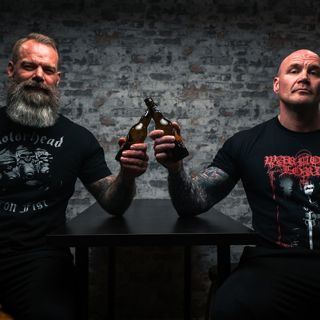
Best Of: Ruth Ozeki’s Enchanted Relationship to Minds and Possessions
Today we're taking a short break and re-releasing one of our favorite episodes from 2022, a conversation with the novelist and Buddhist priest Ruth Ozeki. We'll be back with new episodes next week!The world has gotten louder, even when we’re alone. A day spent in isolation can still mean a day buffeted by the voices on social media and the news, on podcasts, in emails and text messages. Objects have also gotten louder: through the advertisements that follow us around the web, the endless scroll of merchandise available on internet shopping sites and in the plentiful aisles of superstores. What happens when you really start listening to all these voices? What happens when you can’t stop hearing them?Ruth Ozeki is a Zen Buddhist priest and the author of novels including “A Tale for the Time Being,” which was shortlisted for the Booker Prize, and “The Book of Form and Emptiness,” which I read over paternity leave and loved. “The Book of Form and Emptiness” is about Benny, a teenager who starts hearing objects speak to him right after his father’s death, and it’s about his mother, Annabelle, who can’t let go of anything she owns, and can’t seem to help her son or herself. And then it’s about so much more than that: mental illnesses and materialism and consumerism and creative inspiration and information overload and the power of stories and the role of libraries and unshared mental experiences and on and on. It’s a book thick with ideas but written with a deceptively light, gentle pen.Our conversation begins by exploring what it means to hear voices in our minds, and whether it’s really so rare. We talk about how Ozeki’s novels begin she hears a character speaking in her mind, how meditation can teach you to detach from own internal monologue, why Marie Kondo’s almost animist philosophy of tidying became so popular across the globe, whether objects want things, whether practicing Zen has helped her want less and, my personal favorite part, the dilemmas posed by an empty box with the words “empty box” written on it.Mentioned:The Great Shift by James L. KugelBook recommendations:When You Greet Me I Bow by Norman FischerThe Aleph and Other Stories by Jorge Luis BorgesVibrant Matter by Jane BennettThis episode contains a brief mention of suicidal ideation. If you are having thoughts of suicide, call the National Suicide Prevention Lifeline at 1-800-273-8255 (TALK). A list of additional resources is available at SpeakingOfSuicide.com/resources.Thoughts? Guest suggestions? Email us at ezrakleinshow@nytimes.com.You can find transcripts (posted midday) and more episodes of “The Ezra Klein Show” at nytimes.com/ezra-klein-podcast, and you can find Ezra on Twitter @ezraklein. Book recommendations from all our guests are listed at https://www.nytimes.com/article/ezra-klein-show-book-recs.This episode of “The Ezra Klein Show” was produced by Annie Galvin, Jeff Geld and Rogé Karma; fact-checking by Michelle Harris; original music by Isaac Jones; mixing by Jeff Geld; audience strategy by Shannon Busta. Special thanks to Kristin Lin and Kristina Samulewski. Subscribe today at nytimes.com/podcasts or on Apple Podcasts and Spotify. You can also subscribe via your favorite podcast app here https://www.nytimes.com/activate-access/audio?source=podcatcher. For more podcasts and narrated articles, download The New York Times app at nytimes.com/app.
29 Heinä 202258min

The Mid-Century Media Theorists Who Saw What Was Coming
“At the very heart of democracy is a contradiction that cannot be resolved, one that has affected free societies from ancient Greece to contemporary America,” write Zac Gershberg and Sean Illing in their new book, “The Paradox of Democracy.” In order to live up to its name, democracy must be open to free communication and expression; yet that very feature opens democracies up to the forces of chaos, fragmentation and demagoguery that undermine them. Historically, this paradox becomes particularly profound during transitions between different communication technologies. “We see this time and again,” Gershberg and Illing write, “media continually evolve faster than politics, resulting in recurring patterns of democratic instability.”For that reason, Gershberg and Illing refer to media ecology — a field dedicated to studying the complex interplay between media, humans and their broader social environments — as “the master political science.” You can’t understand a society’s politics without understanding the mediums through which its people communicate. Radio and TV and Twitter and TikTok each profoundly shape the way we think, the qualities we look for in our politicians, the way we absorb news, the kind of political discourse we engage in and so much more.Illing’s career, in many ways, represents the intersection of these two worlds: He’s trained as a political theorist but eventually switched careers to become a journalist; he’s currently the interviews writer at Vox, where he hosts the podcast “Vox Conversations” and often writes about the nexus of media and politics. So I invited Illing on the show to talk about his new book alongside some of his other work. We discuss: Why mid-century media theorists like Marshall McLuhan and Neil Postman are essential for understanding our current political momentHow the mediums through which we communicate — TV, social media, print news — shape us even more deeply than the content we absorb from themThe surprising dangers of “Sesame Street”Why Abraham Lincoln probably never would have won the presidency in the TV eraHow revolutions in media technology from the printing press to Facebook have destabilized political systemsHow Twitter reshapes the thinking of those who use itWhy Illing believes that democracy is fundamentally a “communicative culture” and not a set of rules and institutionsWhat Donald Trump understood about our media age that the media itself didn’tWhy Steve Bannon’s “flood the zone” media strategy has been so successfulWhether it’s possible to achieve a healthier version of political discourse given our current technologiesAnd much moreThis episode contains strong language.Mentioned:“‘Flood the zone with shit’: How misinformation overwhelmed our democracy” by Sean Illing“Quantifying partisan news diets in Web and TV audiences” by Daniel Muise, Homa Hosseinmardi, Baird Howland, Markus Mobius, David Rothschild and Duncan J. WattsBook Recommendations:Amusing Ourselves to Death by Neil PostmanPublic Opinion by Walter LippmannMediated by Thomas de ZengotitaThoughts? Guest suggestions? Email us at ezrakleinshow@nytimes.com.You can find transcripts (posted midday) and more episodes of “The Ezra Klein Show” at nytimes.com/ezra-klein-podcast, and you can find Ezra on Twitter @ezraklein. Book recommendations from all our guests are listed at https://www.nytimes.com/article/ezra-klein-show-book-recs.“The Ezra Klein Show” is produced by Annie Galvin and Rogé Karma; fact-checking by Michelle Harris, Rollin Hu, Mary Marge Locker and Kate Sinclair; original music by Isaac Jones; mixing by Sonia Herrero, Carole Sabouraud and Isaac Jones; audience strategy by Shannon Busta. Special thanks to Kristin Lin and Kristina Samulewski. Subscribe today at nytimes.com/podcasts or on Apple Podcasts and Spotify. You can also subscribe via your favorite podcast app here https://www.nytimes.com/activate-access/audio?source=podcatcher. For more podcasts and narrated articles, download The New York Times app at nytimes.com/app.
26 Heinä 20221h 2min

A Top Mental Health Expert on Where America Went Wrong
There’s a paradox that sits at the center of our mental health conversation in America. On the one hand, our treatments for mental illness have gotten better and better in recent decades. Psychopharmaceuticals have improved considerably; new, more effective methods of psychotherapy have been developed; and we’ve reached a better understanding of what kinds of social support are most helpful for those experiencing mental health crises.But at the same time, mental health outcomes have moved in exactly the wrong direction. In the United States, there is a death by suicide about every 11 minutes, and about half of those who die by that method have not received mental health care. Rates of anxiety, depression and eating disorders have skyrocketed among young people in recent years. From 2009 to 2015, rates of emergency room visits for self-harm more than doubled for girls ages 10 to 14.Thomas Insel understands the contours of this disconnect as well as anyone. A psychiatrist and researcher, he was the director of the National Institute of Mental Health for 13 years, and has served as a special adviser on mental health care to California’s governor, Gavin Newsom. But in his new book, “Healing: Our Path from Mental Illness to Mental Health,” he admits that even the herculean efforts made by the mental health community have fallen short. The book explores how badly we’re failing at mental health care, and how much more we could do with what we have already discovered, and what we already know. “Put simply, the mental health problem is medical,” he writes, “but the solutions are not just medical — they are social, environmental, and political.”In this conversation, we discuss why our current medical system is so inadequate at helping people with mental illnesses of all stripes, why psychiatric research and patient outcomes are so wildly out of step, the story of how the U.S. government systematically divested from mental health care in the 1980s, and the fragmented system of care that those decisions created. We also touch on why it’s so difficult to find the right therapist; which treatments we know work really well — and why we so often fail to implement them; why mental health is not just a medical problem, but also an economic and social one; what public policy can, and importantly can’t, do to solve our mental health crisis; the relationship between loneliness and mental illness; how the loosening of family and social ties is impacting our collective mental health and more.Mentions:“Wealth-Care Reform” by Ezra Klein“Together” by Vivek Murthy“Vivek Murthy on America’s Loneliness Epidemic” episode from Vox ConversationsBook Recommendations:Nobody’s Normal by Roy Richard GrinkerAmerican Psychosis by E. Fuller TorreyCrazy by Pete EarleyThoughts? Guest suggestions? Email us at ezrakleinshow@nytimes.com.You can find transcripts (posted midday) and more episodes of “The Ezra Klein Show” at nytimes.com/ezra-klein-podcast, and you can find Ezra on Twitter @ezraklein. Book recommendations from all our guests are listed at https://www.nytimes.com/article/ezra-klein-show-book-recs.“The Ezra Klein Show” is produced by Annie Galvin and Rogé Karma; fact-checking by Michelle Harris, Mary Marge Locker and Kate Sinclair; mixing by Sonia Herrero, Carole Sabouraud and Isaac Jones; original music by Isaac Jones; audience strategy by Shannon Busta. Special thanks to Kristin Lin and Kristina Samulewski. Subscribe today at nytimes.com/podcasts or on Apple Podcasts and Spotify. You can also subscribe via your favorite podcast app here https://www.nytimes.com/activate-access/audio?source=podcatcher. For more podcasts and narrated articles, download The New York Times app at nytimes.com/app.
22 Heinä 20221h 11min

Why Housing Is So Expensive — Particularly in Blue States
America is experiencing a housing crisis — or, more accurately, multiple housing crises. A massive housing shortage in major cities has resulted in skyrocketing rents. Low- and middle-income individuals find themselves priced out of the places with the most opportunity. Homelessness is rampant in cities across the country. Developers often face the steepest obstacles to building in the places where new housing is needed most. And young people are increasingly viewing homeownership, once a vital part of the American dream, as hopelessly out of reach.These outcomes weren’t inevitable. Plenty of other countries supply their populations with high-quality housing at lower prices. And the solutions here are incredibly simple: Build more housing in places where it’s needed, build cheaper forms of housing, build housing alongside public transit, provide more housing vouchers. So why don’t we act on them?Jenny Schuetz is a senior fellow at the Brookings Institution and the author of the new book “Fixer Upper: How to Repair America’s Broken Housing Systems,” which is perhaps the best, clearest overview of America’s housing problems to date. We discuss why the states with the highest homelessness rates are all governed by Democrats, the roots of America’s homelessness crisis, why economists believe the U.S. gross domestic product could be over a third — a third! — higher today if American cities had built more housing, why it’s so hard to build housing where it’s needed most, the actual (and often misunderstood) causes of gentrification, why public housing has such a bad reputation in the U.S.; how progressives’ commitment to local democracy and community voice surprisingly lies at the heart of America’s housing crises, why homeownership is still the primary vehicle of wealth accumulation in America (and the toxic impact that has on our politics), what the U.S. can learn from the housing policies of countries like Germany and France, what it would take to build a better politics of housing and much more.Mentioned:“The Left-NIMBY canon” by Noah SmithThe Homevoter Hypothesis by William A. FischelThe Paradox of Democracy by Zac Gershberg and Sean IllingRecommendations:Crabgrass Frontier by Kenneth T. JacksonNeighborhood Defenders by Katherine Levine Einstein, David M. Glick and Maxwell PalmerMaid (Netflix series)Thoughts? Guest suggestions? Email us at ezrakleinshow@nytimes.com.You can find transcripts (posted midday) and more episodes of “The Ezra Klein Show” at nytimes.com/ezra-klein-podcast, and you can find Ezra on Twitter @ezraklein. Book recommendations from all our guests are listed at https://www.nytimes.com/article/ezra-klein-show-book-recs.“The Ezra Klein Show” is produced by Annie Galvin and Rogé Karma; fact-checking by Michelle Harris, Mary Marge Locker, Kate Sinclair and Rollin Hu; mixing by Sonia Herrero and Isaac Jones; original music by Isaac Jones; audience strategy by Shannon Busta. Special thanks to Kristin Lin and Kristina Samulewski. Subscribe today at nytimes.com/podcasts or on Apple Podcasts and Spotify. You can also subscribe via your favorite podcast app here https://www.nytimes.com/activate-access/audio?source=podcatcher. For more podcasts and narrated articles, download The New York Times app at nytimes.com/app.
19 Heinä 20221h 16min

A Weird, Wonderful Conversation With Kim Stanley Robinson
Kim Stanley Robinson is one of the great living science fiction writers and one of the most astute observers of how planets look, feel and work. His Mars Trilogy imagined what it might be like for humans to settle on the red planet. His best-selling novel “The Ministry for the Future” is a masterful effort at envisioning what might happen to Earth in a future of unchecked climate change. Robinson has a rare command of both science and human nature, and his writing crystallizes how the two must work together if we are to rescue our collective planetary future from possible ruin.In his most recent book, a rare turn to nonfiction called “The High Sierra: A Love Story,” Robinson trains his attention on the planet we inhabit in the here and now, particularly on one of his favorite places on Earth: the Sierra Nevada mountain range in California and Nevada. The new book is part memoir, part guidebook, part meditation on how time, space and even politics take shape in a wondrous geological landscape.We discuss why Robinson decided to start writing outdoors, what it was like to experience the Sierras on psychedelics in his youth, what “actor-network theory” is and how it helps us understand our relationship to the planet and to our own bodies, why we should think of climate change more like we do plane crashes, what hiking backpacks say about American consumerism, how we should change our relationship to technology in order to be happier, why the politics of wanting are so confusing yet important, why Robinson is so excited about ideas like a wage ratio and rewilding schemes, how the “structure of feeling” around climate has changed, why Robinson is feeling more hopeful about Earth’s future these days and more.Mentioned:“The Most Important Book I’ve Read This Year” by Vox Conversations“Your Kids Are Not Doomed” by Ezra Klein“Design for the Real World” by Victor Papanek“Thomas Piketty’s Case for ‘Participatory Socialism’” by The Ezra Klein ShowBook Recommendations:A Brief History of Equality by Thomas PikettyThe Dawn of Everything by David Graeber and David WengrowThe Echo Maker by Richard PowersThoughts? Guest suggestions? Email us at ezrakleinshow@nytimes.com.You can find transcripts (posted midday) and more episodes of “The Ezra Klein Show” at nytimes.com/ezra-klein-podcast, and you can find Ezra on Twitter @ezraklein. Book recommendations from all our guests are listed at https://www.nytimes.com/article/ezra-klein-show-book-recs.“The Ezra Klein Show” is produced by Annie Galvin and Rogé Karma; fact-checking by Michelle Harris, Mary Marge Locker and Kate Sinclair; original music by Isaac Jones; mixing by Isaac Jones and Sonia Herrero; audience strategy by Shannon Busta. Our executive producer is Irene Noguchi. Special thanks to Kristin Lin and Kristina Samulewski. Subscribe today at nytimes.com/podcasts or on Apple Podcasts and Spotify. You can also subscribe via your favorite podcast app here https://www.nytimes.com/activate-access/audio?source=podcatcher. For more podcasts and narrated articles, download The New York Times app at nytimes.com/app.
15 Heinä 20221h 32min

First Person: To Fight for Ukraine’s Freedom, He Went Back Into the Closet
Today, we're bringing you an episode from the recently launched New York Times Opinion podcast, “First Person,” hosted by Lulu Garcia-Navarro. In each episode, Lulu sits down with people living through the headlines for intimate and surprising conversations that help us make sense of our complicated world. This particular episode is about one gay Ukranian soldier’s experience fighting against Russia. Since the beginning of the war, Ukrainians of all backgrounds have come together to fight their common enemy, Russia. But for some Ukrainians, that enemy holds particular terror. In Russia, gay people are routinely targeted for their identity — arrested without cause and even tortured. That’s what motivated Oleksandr Zhuhan to join the volunteer Territorial Defense Forces, despite experiencing homophobia in Ukraine. In the months since, Zhuhan has been fighting two battles: one for his country and one for his identity.You can find transcripts (posted midday) and more information for all episodes at nytimes.com/column/first-person. “First Person” is produced by Derek Arthur, Christina Djossa, Jason Pagano, Cristal Duhaime, Olivia Natt and Courtney Stein. The show is edited by Kaari Pitkin, Stephanie Joyce and Lisa Tobin. Scoring by Isaac Jones, Pat McCusker and Carole Sabouraud. Mixing by Isaac Jones. Fact-checking by Mary Marge Locker. Audience strategy by Shannon Busta, with editorial support from Kristina Samulewski. The executive producer of Opinion audio is Irene Noguchi, and the director of New York Times audio is Paula Szuchman. Special thanks to Jeffrey Miranda, Kate Sinclair, Patrick Healy and Katie Kingsbury. Subscribe today at nytimes.com/podcasts or on Apple Podcasts and Spotify. You can also subscribe via your favorite podcast app here https://www.nytimes.com/activate-access/audio?source=podcatcher. For more podcasts and narrated articles, download The New York Times app at nytimes.com/app.
12 Heinä 202238min

Michelle Goldberg Grapples With Feminism After Roe
“It’s true: We’re in trouble,” writes Michelle Goldberg of the modern feminist movement. “One thing backlashes do is transform a culture’s common sense and horizons of possibility. A backlash isn’t just a political formation. It’s also a new structure of feeling that makes utopian social projects seem ridiculous.”It wouldn’t be fair to blame the Supreme Court decision in Dobbs v. Jackson Women’s Health Organization and the ensuing wave of draconian abortion laws sweeping the nation on a failure of persuasion, or on a failure of the women’s movement. But signs of anti-feminist backlash are permeating American culture: Girlbosses have become figures of ridicule, Amber Heard’s testimony drew a fire hose of misogyny, and recent polling finds that younger generations — both men and women — are feeling ambivalent about whether feminism has helped or hurt women. A movement that has won so many victories in law, politics and public opinion is now defending its very existence.Goldberg is a columnist for Times Opinion who focuses on gender and politics. In recent weeks, she has written a series of columns grappling with the overturning of Roe v. Wade, but also considering the broader atmosphere that created so much despair on the left. What can feminists — and Democrats more broadly — learn from anti-abortion organizers? How has the women’s movement changed in the half-century since Roe, and where can the movement go after this loss? Has feminism moved too far away from its early focus on organizing and into the turbulent waters of online discourse? Has it become a victim of its own success?We discuss a “flabbergasting” poll about the way young people — both men and women — feel about feminism, why so many young people have become pessimistic about heterosexual relationships, how the widespread embrace of feminism defanged its politics, why the anti-abortion movement is so good at recruiting and retaining activists — and what the left can learn from them, how today’s backlash against women compares to that of the Reagan years, why nonprofits on the left are in such extreme turmoil, why a social movement’s obsession with “cringe” can be its downfall, how “safe spaces” on the left started to feel unsafe, why feminism doesn’t always serve poor women, whether the #MeToo movement was overly dismissive of “due process” and how progressives could improve the way they talk about the family and more.Mentioned:“The Future Isn’t Female Anymore” by Michelle Goldberg“Amber Heard and the Death of #MeToo” by Michelle GoldbergRethinking Sex by Christine EmbaThe Case Against the Sexual Revolution by Louise PerryBad Sex by Nona Willis Aronowitz“Elephant in the Zoom” by Ryan Grim“The Tyranny of Structurelessness” by Jo Freeman“Lessons From the Terrible Triumph of the Anti-Abortion Movement” by Michelle GoldbergThe Making of Pro-Life Activists by Ziad W. MunsonSteered by the Reactionary: What To Do About Feminism by The DriftBook Recommendations:Backlash by Susan FaludiNo More Nice Girls by Ellen WillisStatus and Culture by W. David MarxThoughts? Guest suggestions? Email us at ezrakleinshow@nytimes.com.You can find transcripts (posted midday) and more episodes of “The Ezra Klein Show” at nytimes.com/ezra-klein-podcast, and you can find Ezra on Twitter @ezraklein. Book recommendations from all our guests are listed at https://www.nytimes.com/article/ezra-klein-show-book-recs.“The Ezra Klein Show” is produced by Annie Galvin and Rogé Karma; fact-checking by Michelle Harris and Kate Sinclair; original music by Isaac Jones; mixing by Sonia Herrero and Isaac Jones; audience strategy by Shannon Busta. Our executive producer is Irene Noguchi. Special thanks to Kristin Lin and Kristina Samulewski. Subscribe today at nytimes.com/podcasts or on Apple Podcasts and Spotify. You can also subscribe via your favorite podcast app here https://www.nytimes.com/activate-access/audio?source=podcatcher. For more podcasts and narrated articles, download The New York Times app at nytimes.com/app.
8 Heinä 20221h 20min

Liberals Need a Clearer Vision of the Constitution. Here’s What It Could Look Like.
For decades now, the conservative legal movement has been on a mission to remake this nation’s laws from the bench. And it’s working. On Friday we released an episode with the legal scholar Kate Shaw that walked through case after case showing how conservative Supreme Court majorities have lurched this country’s laws to the right on guns, voting, gerrymandering, regulatory authority, unions, campaign finance and more in the past 20 years. And if the Dobbs majority is any indication, this rightward shift is just getting started.But this conservative legal revolution is only half of the story. The other half is just as important: the collapse of liberal constitutional thinking. Liberals have “lost anything that would animate a positive theory of what the Constitution should be,” says the legal scholar Larry Kramer. “And so they’ve been left with a kind of potpourri of leftover things from the periods when liberals were ascendant in the ’60s and ’70s.”Kramer is a former dean of Stanford Law School, the current president of the William and Flora Hewlett Foundation and the author of“The People Themselves: Popular Constitutionalism and Judicial Review.” And according to him, it hasn’t always been this way. For most of American history, politicians, from Jefferson to Lincoln to Franklin Roosevelt, believed that constitutional interpretation was inextricable from politics. And they put forward distinct visions of what the Constitution meant and the kind of country it was written to build. But then, in response to the progressive victories of the Warren court, liberals began to embrace the doctrine of judicial supremacy: the view that the final authority on the Constitution rests with the courts. This has resulted in both the conservative legal victories of the past few decades and liberals’ muddled, weak response.So this is a conversation about the collapse of liberal constitutional politics: why it happened, what we can learn from it and what a renewed, progressive vision of the Constitution could look like. We also discuss why the founders weren’t actually originalists at all, whether liberal constitutional thinking has been captured by the legal profession, what a liberal alternative to originalism could consist of, why changing the size of the court (despite its controversies) has been an important tool for staving off constitutional crisis, the case for an “anti-oligarchy Constitution,” the merits of imposing supermajority requirements on court decisions and nominations, why Kramer views Roosevelt’s infamous court-packing effort as a major success and more.Mentioned:Larry Kramer’s testimony at the Presidential Commission on the Supreme Court of the United States“Judicial Supremacy and the End of Judicial Restraint” by Larry D. Kramer“Marbury and the Retreat from Judicial Supremacy” by Larry D. Kramer“The Judicial Tug of War” by Adam Bonica and Maya SenBook recommendations:The Anti-Oligarchy Constitution by Joseph Fishkin and William E. ForbathThe Second Creation by Jonathan GienappWhen We Cease to Understand the World by Benjamín LabatutWe’re hiring a researcher! You can apply here or by visiting nytimes.wd5.myworkdayjobs.com/NewsThoughts? Guest suggestions? Email us at ezrakleinshow@nytimes.com.You can find transcripts (posted midday) and more episodes of “The Ezra Klein Show” at nytimes.com/ezra-klein-podcast, and you can find Ezra on Twitter @ezraklein. Book recommendations from all our guests are listed at https://www.nytimes.com/article/ezra-klein-show-book-recs.“The Ezra Klein Show” is produced by Annie Galvin and Rogé Karma; fact-checking by Michelle Harris, Mary Marge Locker, Kate Sinclair and Irene Noguchi; original music and mixing by Isaac Jones; audience strategy by Shannon Busta. Our executive producer is Irene Noguchi. Special thanks to Kristin Lin and Kristina Samulewski. Subscribe today at nytimes.com/podcasts or on Apple Podcasts and Spotify. You can also subscribe via your favorite podcast app here https://www.nytimes.com/activate-access/audio?source=podcatcher. For more podcasts and narrated articles, download The New York Times app at nytimes.com/app.
5 Heinä 20221h 13min






















